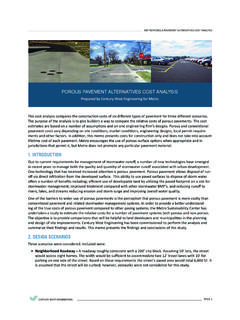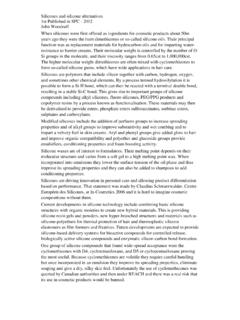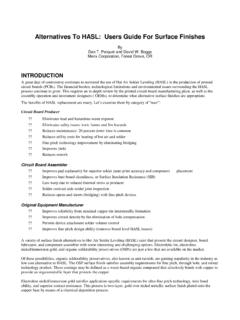Transcription of OECD REPORT ALTERNATIVES TO TRADITIONAL …
1 1 OECD REPORT ALTERNATIVES TO TRADITIONAL REGULATION This REPORT was prepared by Mr. Glen Hepburn, who worked for the OECD Regulatory Policy Division. This document has been declassified and is made available to the public. The views are the author's responsibility. Queries for clarification should be addressed to 2 TABLE OF CONTENTS ALTERNATIVES TO TRADITIONAL REGULATION .. 4 Introduction .. 4 Encouraging consideration of ALTERNATIVES .. 4 A framework for assessing regulatory ALTERNATIVES .. 4 Market-based instruments .. 5 Self-regulation and co-regulation.
2 6 Information and education .. 7 ALTERNATIVES TO TRADITIONAL REGULATION .. 8 Introduction .. 8 ENCOURAGING CONSIDERATION OF ALTERNATIVES .. 9 Introduction .. 9 Why regulate? .. 9 How to regulate and achieve policy objectives? .. 9 What are some of the impediments to using ALTERNATIVES to TRADITIONAL regulation? .. 11 Uncertainty and perceptions of risk .. 11 Institutional impediments .. 13 Overcoming impediments: a supportive policy making process .. 14 Ultimately cultural change is required .. 17 A FRAMEWORK FOR ASSESSING REGULATORY ALTERNATIVES .. 18 Effectiveness.
3 18 Efficiency .. 19 Equity and fairness considerations .. 20 Summary: A framework to guide the choice of policy instrument .. 21 ALTERNATIVES TO TRADITIONAL REGULATION: MARKET-BASED INSTRUMENTS .. 22 1 Introduction .. 22 2. What are market-based instruments? .. 22 When are market-based instruments commonly used?.. 23 3. Assessment of the advantages and disadvantages of market-based instruments .. 26 Effectiveness .. 26 Efficiency .. 29 Equity and fairness .. 32 ALTERNATIVES TO TRADITIONAL REGULATION: SELF-REGULATION AND CO-REGULATION .. 34 1 Introduction.
4 34 2. What are self-regulation and co-regulation? .. 34 When are self and co-regulation commonly used? .. 36 3. Assessment of the advantages and disadvantages of self and co-regulation .. 39 3 Effectiveness .. 39 Efficiency .. 45 Equity and fairness .. 47 ALTERNATIVES TO TRADITIONAL REGULATION: INFORMATION AND EDUCATION .. 50 1 Introduction .. 50 2. What are information and education policy instruments? .. 50 When are information and education commonly used as policy instruments? .. 51 3. Assessment of the advantages and disadvantages of information and education.
5 51 Effectiveness .. 51 Efficiency .. 54 Equity and fairness .. 55 SUMMARY AND CONCLUSIONS .. 57 Summarising the characteristics of the different alternative instruments .. 57 Market-based instruments .. 57 Self and co-regulation .. 59 Information and 60 A check list for considering alternative instruments .. 61 Scope for future work .. 63 BIBLIOGRAPHY .. 65 Boxes Box 1. The OECD Reference Checklist for Regulatory Decision-Making .. 15 Box 2. Getting maximum benefit from RIA: best practices .. 16 Box 3. Market-based Instruments: Some Examples .. 23 Box 4.
6 Environmental taxes in Norway .. 24 Box 5. EU trading scheme for carbon dioxide emissions .. 24 Box 6. Instruments of self-regulation: some examples .. 34 Box 7. Codes of practice under the Australian trade practices act .. 35 Box 8. Spanish self-regulation of software labelling and advertising .. 38 Box 9. An Industry code of practice as an alternative to TRADITIONAL regulation .. 40 Box 10. Professional self-regulation: pricing concerns in Norway .. 41 Box 11. European Electrotechnical Standardisation .. 46 Box 12. Information and Education Policy Instruments: Some Examples.
7 51 4 ALTERNATIVES TO TRADITIONAL REGULATION Introduction This REPORT updates and extends the earlier work of the OECD on ALTERNATIVES to TRADITIONAL regulation, drawing on the experiences of individual countries in using alternative approaches. It also provides a framework to assist policy makers in selecting those instruments that are particularly applicable in different circumstances, facilitating the desire of many countries to reduce red tape and the burdens imposed on agents by unnecessary or overly prescriptive regulation.
8 Consideration of alternative instruments is a key element in the 1995 OECD checklist for regulatory decision-making and greater guidance to policy makers can help ensure that ALTERNATIVES are more fully considered. The challenge for government is to ensure that the regulations and instruments it uses to achieve the public s objectives are both effective and efficient: effective in the sense that they resolve the problem they were introduced to address; and efficient in the sense that they minimise both the direct compliance costs borne by those subject to the regulation, and other, often more indirect, costs which may be imposed on the public.
9 Encouraging consideration of ALTERNATIVES The first response by governments to a perceived policy issue is often to regulate, but it may be appropriate to ask whether TRADITIONAL regulation is the best possible course of action. In many situations there may be a range of options other than TRADITIONAL command and control regulation available, including more flexible forms of TRADITIONAL regulation (such as performance-based and incentive approaches), co-regulation and self-regulation schemes, incentive and market based instruments (such as tax breaks and tradable permits) and information approaches.
10 There continues to be considerable experimentation with the use of ALTERNATIVES in OECD countries, but policy makers remain reluctant to seriously consider the use of alternative instruments in many situations, perhaps because of the uncertainties and perceived risks attached to alternative approaches, or because of institutional impediments. Some obstacles can be overcome by developing policy-making processes that involve a thorough consideration of the advantages and disadvantages of the options available, such as regulatory impact analysis (RIA).
















